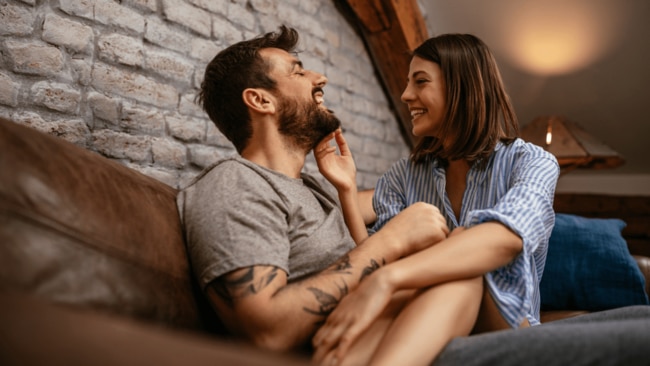New research shows the orgasm gap is alive and well – here’s what’s going wrong
And find out how to fix it
Lifestyle
Don't miss out on the headlines from Lifestyle. Followed categories will be added to My News.
We’ve been talking about the ‘orgasm gap’ for decades but what have we actually learnt? New research from the Body+Soul 2024 Sex Census shows there’s still a huge disparity between the number of times men and women are getting their worlds rocked.
It’s 2024 and I’m still mad because Hollywood continues to be the biggest perpetrator of the world’s biggest cover-up in our sexual education: that all women need is a few pumps of penetration and *hey presto*, they orgasm.
Why are we still trying to validate this myth? And not the one that women are easily pleased in bed, and that men and women are always going to climax at precisely the same time, right on queue.
Consider that myth well and truly busted. New research from the Body+Soul 2024 Sex Census shows just one in four singles orgasm every time they have sex. And that it’s even worse when we break down the stats.
What is the orgasm gap?
“The orgasm gap is the literal gap between the number of orgasms that specifically heterosexual, cisgendered men and women are having,” somatic sexologist Alice Child tells Body+Soul.
“Specifically within straight relationships there's a huge discrepancy between how consistently and reliably both partners are able to come,” the sexpert explains. “So men are able to orgasm a lot more frequently than reports of women being able to orgasm in those encounters and experiences and relationships.”
Case in point? 44 per cent of men orgasm every single time they have sex, compared to just 16 per cent of women, according to data from the Body+Soul 2024 Sex Census.

What is the cause of the orgasm gap?
“How much time do you have?” asks Child, citing many reasons there gap has continued to exist after all this time.
But all jokes aside, here are some of the most common reasons why women aren’t climaxing as often as men.
#1. We go in way too quickly
Did you know that it takes at least about 20 minutes on average for the clitoris to become fully engorged, filled with blood and ready for pleasure, both externally and internally?
“Very few people know that because there’s this lack of understanding of female bodies and there’s been such a history of underfunding and under research of female sexuality in Western medicine and education,” Child says. “So very few people know that’s how much time the female body needs before pleasure is really readily accessible.”
So what happens instead? We go into sex way too fast.
“A lot of people are rushing ahead too quickly and going straight to penetration before the body is ready and expecting the female body to be able to reach these orgasmic states before that engorgement has happened,” explains the sexologist.
Which is kind of like expecting a penis to be able to ejaculate before it’s fully erect. “So that’s the sort of pressure that people are putting on themselves or their partner’s bodies, and we’re just not really slowing down.”

#2. We expect penetration alone to do the job
“There are a lot of stories around sex in our society and a lot of myths around what sex is, and a big one is society saying that sex is penis in vagina,” Child says. “It's what you see in movies and in porn and in those depictions women are often orgasming pretty easily and regularly from penetrative sex.
So that’s what people assume happens in real life too.
“The reality is that penetrative sex alone very, very rarely leads to orgasm for most people with vulvas,” the expert explains. “Depending on which research paper you read, it could be anything from 80 to 90 per cent of women needing consistent clitoral stimulation externally in order to reach orgasm. So penetration alone is rarely enough.”

#3. We focus too much on the penis
The type of sex we’re having is also very penis-focused, Child says.
“Think about what people do on their own to give themselves pleasure,” she says. “For a lot of penis owners, that's an up and down motion with a quite firm, quite fast masturbation pattern.”
Now let’s think about how a lot of women get themselves off.
“When they masturbate, it's often a lot slower. It's circling, it's grinding, it's toys on the clitoris. And then when a man and a woman come together, and I’m generalising here, but a lot of people go straight to that penis focused in and out, up and down motion when actually what a lot of women need, or have trained their body to need, is that sort of grinding, circling, vibration, kind of motion.”
Square peg in a round hole, anyone?

#4. We’re not asking for what we want
Whether that’s because we know what we want but we’re too nervous to ask for it, or because we don’t even know what we want in the first place, many women struggle to speak up about their sexual preferences.
“Very few people have that cognitive awareness about what their body needs or they have a lack of confidence to ask for it and to find their voice,” claims Child.
Compare these stats for instance. The Body+Soul 2024 Sex Census shows that while one in four singles orgasm every time they have sex, that number jumps to one in three for those in relationships, highlighting the importance of communication and understanding the needs of your partner.

#5. We’re putting others first
“Women are culturally conditioned to be a bit more like people pleasers and to consider someone else's pleasure before our own,” the sexologist says.
“And when a lot of women go a little bit deeper in session with me, they realise that they’ve got this fundamental belief that sex isn't for them and that sex is for the man's pleasure."
It's a tough pill to swallow – and one that can take some serious time and energy to work through.

#6. We don’t believe we deserve pleasure
Tragically, Child says many women believe that they don’t deserve to feel pleasure and that there is a shame involved in relishing in an orgasm.
“It’s like a slut shaming belief that actually if they experience pleasure, that's wrong or that's taboo or it makes them a slut,” she explains.
“So there’s these sort of core beliefs that prevent people from advocating for their own pleasure and orgasm because, on some level, they don't feel worthy of it as well."
"We've created a culture where pleasure is shameful and experiencing pleasure in your body is a problem," adds Child. "I think that impacts everyone, but it definitely impacts a lot of the women that I work with.”

#7. We’ve got confidence issues
“This isn't just a female thing but a lot of women have all sorts of reasons why, in the moment, they find it hard to surrender and orgasm,” says Child. “And orgasm takes a lot of surrender and trust and safety, and all sorts of things can get in the way of that surrender and trust and safety.”
For example, a lot of women have experienced sexual violence, abuse or coercion, so they really struggle to feel safe during sex. Even if they really trust the partner they’re with.
“Often, there's still a barrier,” the sexologist explains. “There's still a tension in their body, there's still a bracing, which really makes it difficult to really reach that level of pleasure and surrender that orgasm takes.”

How to close the gap
With an endless number of reasons for the orgasm gap, solutions to help close it are infinite.
Here are five ways Child suggests we can work to better the bedroom experience for women.
#1. Don’t fake it
“I don't ever wish to shame people for faking orgasms, because there's all sorts of reasons why people do it. But depending on what research you read, up to 85 per cent of women admit to faking orgasms at some point in time,” the expert says.
She claims that lowering this stat would go a long way in lowering the orgasm gap because it only serves to back up the myth that sex has to end in orgasm.
“It’s like the goal of sex and if we haven't orgasmed, then one or both of us has done something wrong, which is simply not true,” Child explains. “I've listed all of those reasons why it can be really challenging and why it might be easy to orgasm on your own and impossible with a partner, or actually, impossible all of the time because lots of women have never orgasmed.”

According to the Body+Soul 2024 Sex Census, five per cent of women haven’t ever reached a climax. That's 528,000 Aussie women.
“So if we have a bit more awareness of that, hopefully, both men and women will become less fixated on this idea that it has to end in orgasm all the time and that you can have very pleasurable sex without orgasm,” Child says. “Which would remove the pressure that a lot of people are putting on themselves to orgasm, which is often why they feel compelled to fake it.”
And faking it serves no one. The woman isn't learning about her own body and what she needs and how to ask for it and advocate for her own pleasure. Plus, her partners are absolutely missing out on learning opportunities because they think they’re killing it.
“They’re like, ‘Great, it turns out that women only need two minutes of foreplay and they only need this doggy style penetration and it works for me and her and that's brilliant’,” Child says. “It matches their view of what they’ve seen in movies and porn and they’ve got no reason to believe otherwise because their lived experiences are the same.”
So while faking it can seem like the easier choice than having The Talk, “We've got to be the change we want to see in the world,” Child says.

#1. See a sexologist
“I think a lot of people associate sex therapy or seeing a sexologist with just sitting and talking about your sexual problems, and it only being for people who have a problem to fix and that’s just not the case,” Child says.
“It can be really fun and empowering. You're getting the chance to learn more about your body, and getting all of the information that you should have been taught in school but nobody does in a really safe, trauma-informed, judgement-free space.”
There’s also the access to understanding how to maximise your pleasure, from tools to techniques.
“It's just giving you a really big toolkit for life and how to feel more and get more out of sex, as well as a good practice for communication and finding your language and finding your voice," adds Child. "And you know, you don't know what you don't know.”

#3. Educate yourself and ask questions
This one is for the heterosexual penis owners.
“I would empower all straight men out there to go and do your own learning about female bodies and orgasms and the clitoris, and get more awareness and knowledge and also understanding,” Child says. “But it's often not as simple as asking someone, ‘Hey, what do you like?’. Often people might go, ‘I'm not sure, I don't know’, because you might be the very first person to ask them that question.”
So don’t despair or give up. Stay curious and judgement-free, have an open mind, and get into the habit of talking about sex after the act.
“Ask, ‘What was your favourite bit? Why was that hot?’,” Child prompts. “Share your highlights and get really curious in those debriefs so you can keep learning together.”

#4. Talk about how you get off
“Obviously, talking about how you masturbate, for some people, is like the most personal question and it can feel very alarming,” the sexologist says. “But push through that discomfort because on the other side are some incredible, connective, hot, juicy experiences.”
So you could ask, ‘What works for you? Is it fantasies, is it books, is it toys? What do you do when you’re by yourself?’
“Or you could even just show each other. Like, ‘Alright why don’t we just touch ourselves in front of each other as a way of learning more about each other's bodies’. That can be a really helpful way if you don't have the words to explain exactly what you do and what feels good.”
#5. Bring out the toys
“Remove this idea that toys are the competition,” Child encourages. “Toys are part of the team. You can invite them in to help out. They offer a really helpful helping hand.”
Can't get enough? For all the spicy details from our nationwide survey, head to bodyandsoul.com.au/sexcensus
More Coverage
Originally published as New research shows the orgasm gap is alive and well – here’s what’s going wrong




